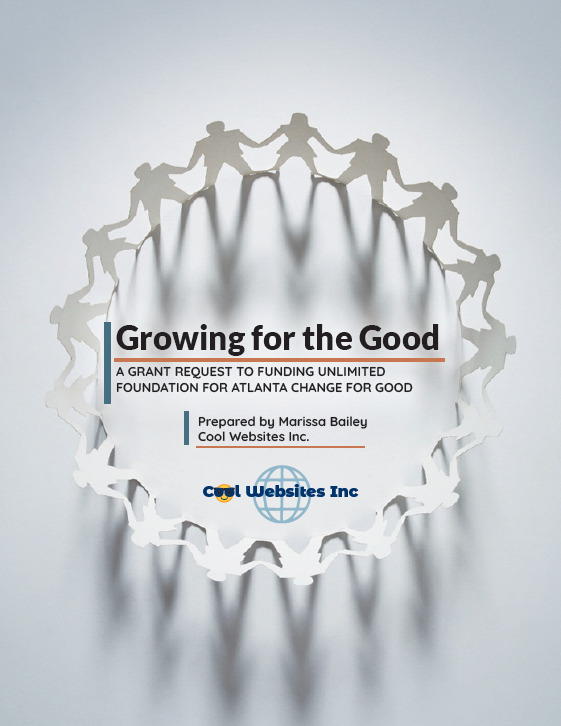Growing for the Good Grant Proposal
A grant proposal for a website redesign project.
Objective
I originally wrote this proposal as part of a two-person project for my Grant and Proposal Writing class. Our assignment asked us to create a fictitious business which we would operate as, choose a real Metro Atlanta non-profit organization, and identify a problem they had that our business could solve. Then, working under the assumption that the non-profit accepted our offer to work for them, we had to write a grant proposal to a funding source willing to support the project. After turning in the assignment for class, I went back and made substantial changes to this document both in content and design.
Tasks
• Create a fictitious business that offers a product or service (this product or service should reflect real knowledge and skills we have)
• Discover a Metro Atlanta non-profit organization who could benefit from our business’s product or service
• Identify a specific problem or opportunity for the non-profit that our business’s product or service would solve
• Research the non-profit organization as thoroughly as possible
• Fill out audience analysis worksheets to determine the best persuasive approach
• Research the service or product our fictitious business offers to fill any knowledge gaps
• Write a proposal to this non-profit organization and present (to our instructor) for approval
• Adapt the proposal into a grant by changing its audience to a fictitious funding source (details for this funding source were provided by our instructor)
Process
I was the lead writer on this proposal, so the majority of writing is mine. My partner made large contributions in terms of creating our fictitious company (they had more background in website design and development), contributing information based on knowledge and experience for the redesign plan, and completing the heuristic evaluation. The redesign plan we put forward in this proposal also showcases the techniques, process, and principles we learned in our classes up to that point.
As with many of my other projects, the key to success with this project was a research-informed approach. After creating our ficticious business, Cool Websites Inc., we researched other website development and redesign companies to understand what they do, how they operate, what services they offer, and what rhetoric they use. This research helped us really flesh out the professional identity of our business and gave us a basis for how to present that identity in our proposal.
In addition to research website development companies, we did substantial research into the non-profit organization we chose. We used this research to fill out several different audience analysis worksheets, which, in turn, informed the rhetorical approach I took in the proposal. I changed the name of the non-profit in the proposal--since this was for a class assignment and the organization has no knowledge we did this, I didn’t want to mislead readers in any way--but it would have been impossible for me to write a proposal without have a real target audience to analyze.
I wrote the first draft of this proposal to the non-profit organization we chose. We then presented it for approval (to our instructor) to mimic the process of writing a business-to-business proposal. Then, I adapted the proposal into a grant targeting a fictitious funding source (which our instructor created for us).
Design
After turning this assignment in, I decided to go back and redesign it by adding images and graphic elements. These elements make the proposal more engaging and add credibility to the fictitious company. I created a logo, letterhead, and color palette to give Cool Websites Inc. its own brand. This touch gives the proposal a sense of professionalism as well as more visual appeal. I also touched up and refined some of the language to more closely adhere to the persona we created for our business.
Takeaways
As with many of my other projects, this project reinforced the value of research-informed design. This project also taught me the value of audience analysis in proposal writing. This proposal would have been much poorer if I hadn’t had a real target audience to analyze and if we hadn’t spent so much time inventing a business persona for ourselves. Understanding the identity of our own professional organization was just as important as understanding the identity of our audience.
